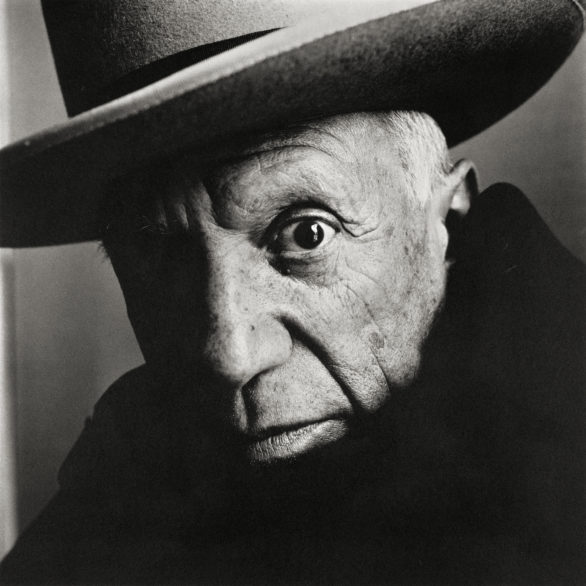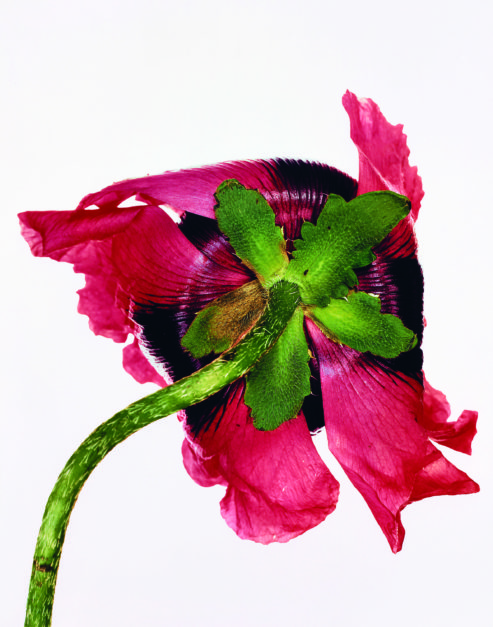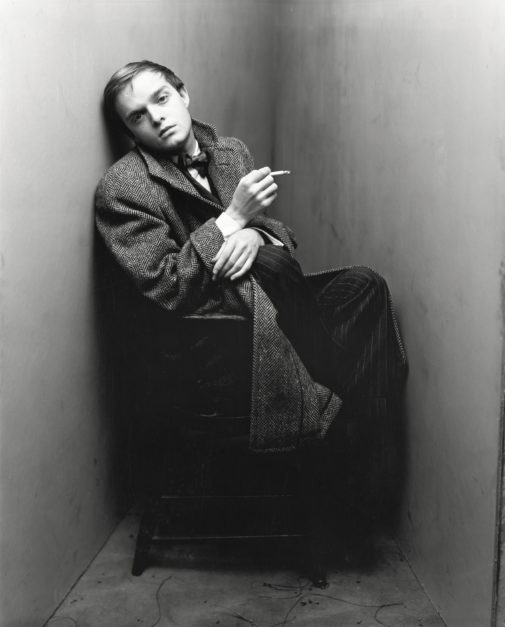Irving Penn — Single Oriental Poppy, New York. 1968, printed 1989. Dye transfer print Image: 21 7/8 x 17 1/8 in. (55.5 x 43.5 cm.).Sheet: 22 15/16 x 18 13/16 in. (58.2 x 47.8 cm.). Overall: 22 15/16 x 18 13/16 in. (58.2 x 47.8 cm.). Promised Gift of The Irving Penn Foundation. IP.139.
______________________________
IRVING PENN: CENTENNIAL
April 24 / July 30
The Metropolitan Museum of Art will present a major retrospective of the photographs of Irving Penn to mark the centennial of the artist’s birth. Over the course of his nearly 70-year career, Irving Penn (1917–2009) mastered a pared-down aesthetic of studio photography that is distinguished for its meticulous attention to composition, nuance, detail, and printmaking. Irving Penn: Centennial, opening April 24, 2017, will be the most comprehensive exhibition of the great American photographer’s work to date and will include both masterpieces and hitherto unknown prints from all his major series.
Long celebrated for more than six decades of influential work at Vogue magazine, Penn was first and foremost a fashion photographer. His early photographs of couture are masterpieces that established a new standard for photographic renderings of style at mid-century, and he continued to record the cycles of fashions year after year in exquisite images characterized by striking shapes and formal brilliance. His rigorous modern compositions, minimal backgrounds, and diffused lighting were innovative and immensely influential. Yet Penn’s photographs of fashion are merely the most salient of his specialties. He was a peerless portraitist, whose perceptions extended beyond the human face and figure to take in more complete codes of demeanor, adornment, and artifact. He was also blessed with an acute graphic intelligence and a sculptor’s sensitivity to volumes in light, talents that served his superb nude studies and life-long explorations of still life.
~~~~~~~~~~~~~~~~~WALL TEXT / INSERT~~~~~~~~~~~~~~~~~
Irving Penn — Truman Capote, New York. March 5, 1948. Gelatin silver print. Image: 10 1/16 x 8 3/16 in. (25.5 x 20.8 cm.). Sheet: 10 1/16 x 8 3/16 in. (25.5 x 20.8 cm.). Overall: 10 1/16 x 8 3/16 in. (25.5 x 20.8 cm.). Promised Gift of The Irving Penn Foundation. P.162.
Existential Portraits, 1947–48
After serving in the war, in 1945 Penn returned to his work at Vogue. To infuse the magazine with culture and boost his associate’s budding career, art director Alexander Liberman asked Penn to make a series of portraits of personalities. The sitters were selected for him, but the set, lighting, and conduct of the sessions were up to thephotographer. Not yet thirty and hardly known, Penn had to find a way to direct the sessions with his famous subjects. He found that cornering them between two angled stage flats was an effective way to control the interaction and amplify their responses. The unfinished nature of the set highlights the artifice of studio portraiture. Likewise, thesitters’ sometimes disproportionate body parts (such as Joe Louis’s narrow shoulders and enormous feet)call attention to the foreshortening distortions of the camera’s lens. Another minimal schema Penn used was an old carpet tossed over boxes. Like the no-exit corner, this barren no-man’s-land seemed appropriate to the psychic tenor of the postwar moment. By 1948 these stark, astute portraits had made Penn’s name.
~~~~~~~~~~~~~~~~~~~~~~~~~~~~~~~~~
Irving Penn — Marlene Dietrich, New York. November 3, 1948, printed April 2000. Gelatin silver print. Image: 10 x 8 1/16 in. (25.4 x 20.4 cm.). Sheet: 10 x 8 1/16 in. (25.4 x 20.4 cm.). Overall: 10 x 8 1/16 in. (25.4 x 20.4 cm.). Promised Gift of The Irving Penn Foundation. IP.105.
Classic Portraits, 1948–62
During the 1950s and early 1960s Penn’s eye, imagination, and technical prowess were in great demand. He divided his time between advertising work and photographing fashion and celebrities forVogue. The magazine’s clout and Penn’s prominence made the invitation to sit for a portrait a badge of prestige few refused. Penn wanted his portraits to be weighty and irreducible, like paintings; he also wanted them to carry sufficient punch to stop Vogue’s readers from turning the page. He studiedthe art of Goya, Daumier, and Toulouse Lautrec for lessons in focus, lighting, and graphic immediacy.The gist of his task was to get past the prepared faces and personal armor of the luminaries who came to sit. He met his subjects honestly, without airs and in blue jeans, and began by putting them at ease over coffee. Then, speaking softly, Penn supported and encouraged his sitters through the arc of the session, gradually melting their defenses and aligning their intent to his. Only when they entered some vital territory together, where truths consolidated or essence was revealed, was he satisfied. The resulting portraits are like no others: their hallmarks of graphic concision and psychological acuity are instantly recognizable.

Irving Penn — Pablo Picasso at La Californie, Cannes. 1957, printed February 1985. Platinum–palladium print. Image: 18 5/8 x 18 5/8 in. (47.3 x 47.3 cm.). Sheet: 24 15/16 x 22 in. (63.3 x 55.9 cm.). Mount: 26 x 22 in. (66 x 55.9 cm.). Overall: 26 x 22 in. (66 x 55.9 cm.). Promised Gift of The Irving Penn Foundation. IP.123.
~~~~~~~~~~~~~~~~~~~~~~~~~~~~~~~~~
Penn dealt with so many subjects throughout his long career that he is conventionally seen either with a single lens—as the portraitist, fashion photographer, or still life virtuoso—or as the master of all trades, the jeweler of journalists who could fine-tool anything. The exhibition at The Met will chart a different course, mapping the overall geography of the work and the relative importance of the subjects and campaigns the artist explored most creatively. Its organization largely follows the pattern of his development so that the structure of the work, its internal coherence, and the tenor of the times of the artist’s experience all become evident.
The exhibition will most thoroughly explore the following series: street signs, including examples of early work in New York, the American South, and Mexico; fashion and style, with many classic photographs of Lisa Fonssagrives-Penn, the former dancer who became the first supermodel as well as the artist’s wife; portraits of indigenous people in Cuzco, Peru; the Small Trades portraits of urban laborers; portraits of beloved cultural figures from Truman Capote, Joe Louis, Picasso, and Colette to Alvin Ailey, Ingmar Bergman, and Joan Didion; the infamous cigarette still lifes; portraits of the fabulously dressed citizens of Dahomey (Benin), New Guinea, and Morocco; the late “Morandi” still lifes; voluptuous nudes; and glorious color studies of flowers. These subjects chart the artist’s path through the demands of the cultural journal, the changes in fashion itself and in editorial approach, the fortunes of the picture press in the age of television, the requirements of an artistic inner voice in a commercial world, the moral condition of the American conscience during the Vietnam War era, the growth of photography as a fine art in the 1970s and 1980s, and personal intimations of mortality. All these strands of meaning are embedded in the images—a web of deep and complex ideas belied by the seeming forthrightness of what is represented.
Penn generally worked in a studio or in a traveling tent that served the same purpose, and favored a simple background of white or light gray tones. His preferred backdrop was made from an old theater curtain found in Paris that had been softly painted with diffused gray clouds. This backdrop followed Penn from studio to studio; a companion of over 60 years, it will be displayed in one of the Museum’s galleries among celebrated portraits it helped create. Other highlights of the exhibition include newly unearthed footage of the photographer at work in his tent in Morocco; issues of Vogue magazine illustrating the original use of the photographs and, in some cases, to demonstrate the difference between those brilliantly colored, journalistic presentations and Penn’s later reconsidered reuse of the imagery; and several of Penn’s drawings shown near similar still life photographs.
~~~~~~~~~~~~~~~~~~~~~~~~~~~~~
Exhibition Credits
Irving Penn: Centennial is co-curated by Maria Morris Hambourg, independent curator and the founding curator of The Met’s Department of Photographs, and Jeff L. Rosenheim, Joyce Frank Menschel Curator in Charge of the Department of Photographs at The Met.
~~~~~~~~~~~~~~~~~~~~~~~~~~~~~
Catalogue
The exhibition is accompanied by a 372-page book with 365 illustrations, including full-page reproductions of all the photographs exhibited, by Maria Morris Hambourg and Jeff L. Rosenheim. A probing introduction to the artist, his concerns, and the evolution of his work is provided by Hambourg, followed by lively in-depth studies of the central themes and episodes of his career, an illustrated chronology, and notes on Penn’s printing by Hambourg, Rosenheim, and guest authors Alexandra Dennett, Philippe Garner, Adam Kirsch, Harald E.L. Prins, and Vasilios Zatse.
The catalogue is made possible by the Samuel I. Newhouse Foundation, Inc., the Mary C. and James W. Fosburgh Publications Fund, and the Roswell L. Gilpatric Publications Fund.
~~~~~~~~~~~~~~~~~~~~~~~~~~~~~
Related Programs
A full program of lectures and a scholarly symposium will be offered during the course of the exhibition, including an evening talk, Leonard A. Lauder on the Photographs of Irving Penn. In this conversation with Jeff Rosenheim, Leonard Lauder (Chairman Emeritus, The Estee Lauder Companies, Inc.; Chairman Emeritus, Whitney Museum of American Art, New York) will recall his long relationship with the artist and his enduring fascination with the iconic American photographer’s work. It will take place on Tuesday, April 25, 2017, at 6:30 p.m., in the Grace Rainey Rogers Auditorium at The Met Fifth Avenue. Tickets start at $45. Details available here.
There will be a Sunday at The Met on June 25 from 2–3:30 p.m. with writer and critic Vince Aletti, Jeff Rosenheim, and others to discuss the life and work of Irving Penn and his magazine photographs. Additionally, Jeff Rosenheim will join two Conversation with a Curator events: On June 1, “Irving Penn’s Photographs of Fashion,” with Andrew Bolton, Curator in Charge, The Costume Institute; and on June 28, “Irving Penn’s Photographs from New Guinea,” with Maia Nuku, Evelyn A. J. Hall and John A. Friede Associate Curator for Oceanic Art, Department of the Arts of Africa, Oceania, and the Americas.
Following its presentation at The Met, the exhibition will travel to Paris (at the Grand Palais, September 2017-January 2018), and subsequently to Berlin and São Paulo.
~~~~~~~~~~~~~~~~~~~~~~~~~~~~~
History of Irving Penn at The Met
The exhibition follows from a magnificent promised gift from The Irving Penn Foundation to The Met in honor of the artist’s centenary of 187 photographs by Penn, representing every period and all facets of the artist’s long career with the camera. Selections from this gift form the core of the exhibition. They are joined by some 50 prints selected from the 145 Penn prints already in the Museum’s collection. These include a suite of 65 nude studies from 1949–50 donated by the artist in 2002 and featured that same year in The Met’s exhibition Earthly Bodies: Irving Penn’s Nudes, 1949–50 and its publication. More recently, in 2014, 64 platinum prints from the artist’s celebrated Small Trades series, 1950-51, depicting laborers with the tools of their trades in Paris, London, and New York, were acquired with funds from an anonymous donor.
Individual photographs by Irving Penn were first acquired and shown by The Met in 1959 in the context of Photography in the Fine Arts exhibitions. The Museum has presented two monographic shows of the artist’s works: in 1977, Curator of Modern Art, Henry Geldzahler, organized Irving Penn: Street Material. Photographs in Platinum Metals, 1975–76; and, in 2002, Maria Morris Hambourg, working closely with the artist, curated Earthly Bodies: Irving Penn’s Nudes, 1949–50.
~~~~~~~~~~~~~~~~~~~~~~~~~~~~
Irving Penn Quotes
“I myself have always stood in awe of the camera. I recognize it for the instrument that it is,part Stradivarius, part scalpel.”
“I don’t think I was overawed by the subjects. I thought we were in the same boat.”
“A beautiful print is a thing in itself.”
“The daylight . . . is the light of Paris, the light of painters. It seems to fall as a caress.”
“Photography is just the present state of man’s visual history.”
“To me personally, photography is a way to overcome mortality.”
——————————————————————————-
www.metmuseum.org
______________


